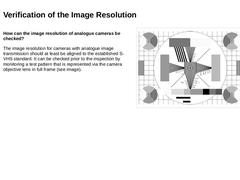
|
How can the image resolution of analogue cameras be checked? The image resolution for cameras with analogue image transmission should at least be aligned to the established S-VHS standard. It can be checked prior to the inspection by monitoring a test pattern that is represented via the camera objective lens in full frame (see image). (Image: Example for the test pattern according to DIN 25435 part 4 to check the image resolution) |
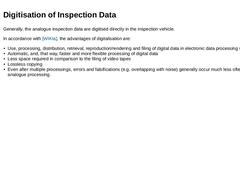
|
Generally, the analogue inspection data are digitised directly in the inspection vehicle. In accordance with [WIKIa], the advantages of digitalisation are: -
Use, processing, distribution, retrieval, reproduction/rendering and filing of digital data in electronic data processing systems
-
Automatic, and, that way, faster and more flexible processing of digital data
-
Less space required in comparison to the filing of video tapes
-
Lossless copying
-
Even …
|
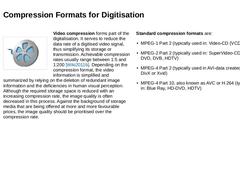
|
(Image: Picto Video Film Filmrolle blau) Video compression forms part of the digitalisation. It serves to reduce the data rate of a digitised video signal, thus simplifying its storage or transmission. Achievable compression rates usually range between 1:5 and 1:200 [Wiki2011b]. Depending on the compression format, the video information is simplified and summarized by relying on the deletion of redundant image information and the deficiencies in human … |
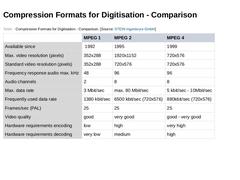
|
(Table: Compression Formats for Digitisation - Comparison) |
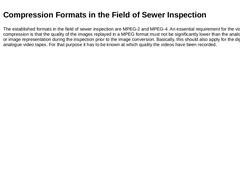
|
The established formats in the field of sewer inspection are MPEG-2 and MPEG-4. An essential requirement for the video compression is that the quality of the images replayed in a MPEG format must not be significantly lower than the analogue recording or image representation during the inspection prior to the image conversion. Basically, this should also apply for the digitalisation of analogue video tapes. For that purpose it has to be known at which … |
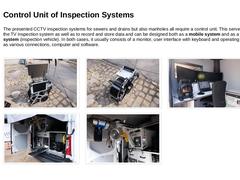
|
The presented CCTV inspection systems for sewers and drains but also manholes all require a control unit. This serves to control the TV inspection system as well as to record and store data and can be designed both as a mobile system and as a stationary system (inspection vehicle). In both cases, it usually consists of a monitor, user interface with keyboard and operating lever as well as various connections, computer and software. (Image: Mobile … |
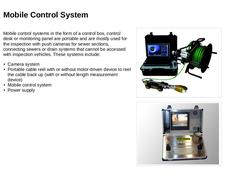
|
Mobile control systems in the form of a control box, control desk or monitoring panel are portable and are mostly used for the inspection with push cameras for sewer sections, connecting sewers or drain systems that cannot be accessed with inspection vehicles. These systems include: -
Camera system
-
Portable cable reel with or without motor-driven device to reel the cable back up (with or without length measurement device)
-
Mobile control system
-
Power …
|
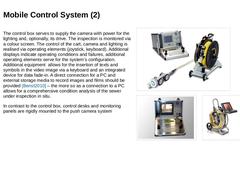
|
The control box serves to supply the camera with power for the lighting and, optionally, its drive. The inspection is monitored via a colour screen. The control of the cart, camera and lighting is realised via operating elements (joystick, keyboard). Additional displays indicate operating conditions and failures, additional operating elements serve for the system’s configuration. Additional equipment allows for the insertion of texts and symbols … |
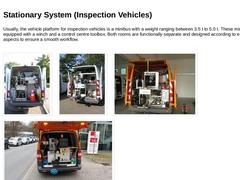
|
Usually, the vehicle platform for inspection vehicles is a minibus with a weight ranging between 3.5 t to 5.0 t. These minibuses are equipped with a winch and a control centre toolbox. Both rooms are functionally separate and designed according to ergonomic aspects to ensure a smooth workflow. (Image: Inspection vehicle for the inspection of sewers and pipes of the company Rico) (Image: Inspection vehicle for the inspection of sewers and pipelines … |
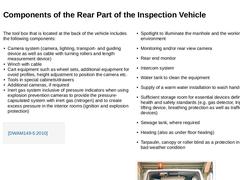
|
The tool box that is located at the back of the vehicle includes the following components: -
Camera system (camera, lighting, transport- and guiding device as well as cable with turning rollers and length measurement device)
-
Winch with cable
-
Cart equipment such as wheel sets, additional equipment for ovoid profiles, height adjustment to position the camera etc.
-
Tools in special cabinets/drawers
-
Additional cameras, if required
-
Inert gas system …
|
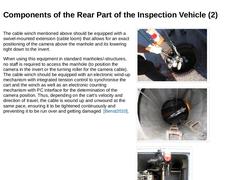
|
The cable winch mentioned above should be equipped with a swivel-mounted extension (cable loom) that allows for an exact positioning of the camera above the manhole and its lowering right down to the invert. When using this equipment in standard manholes/-structures, no staff is required to access the manhole (to position the camera in the invert or the turning roller for the camera cable). The cable winch should be equipped with an electronic wind-… |
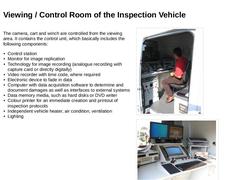
|
The camera, cart and winch are controlled from the viewing area. It contains the control unit, which basically includes the following components: -
Control station
-
Monitor for image replication
-
Technology for image recording (analogue recording with capture card or directly digitally)
-
Video recorder with time code, where required
-
Electronic device to fade in data
-
Computer with data acquisition software to determine and document damages as well …
|
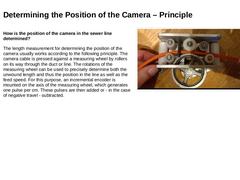
|
How is the position of the camera in the sewer line determined? The length measurement for determining the position of the camera usually works according to the following principle. The camera cable is pressed against a measuring wheel by rollers on its way through the duct or line. The rotations of the measuring wheel can be used to precisely determine both the unwound length and thus the position in the line as well as the feed speed. For this purpose, … |
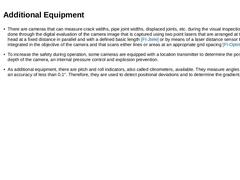
|
-
There are cameras that can measure crack widths, pipe joint widths, displaced joints, etc. during the visual inspection. This is done through the digital evaluation of the camera image that is captured using two point lasers that are arranged at the camera head at a fixed distance in parallel and with a defined basic length [FI-Jtele] or by means of a laser distance sensor that is integrated in the objective of the camera and that scans either lines …
|
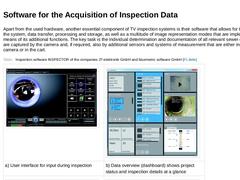
|
Apart from the used hardware, another essential component of TV inspection systems is their software that allows for the control of the system, data transfer, processing and storage, as well as a multitude of image representation modes that are implemented by means of its additional functions. The key task is the individual determination and documentation of all relevant sewer conditions that are captured by the camera and, if required, also by additional … |
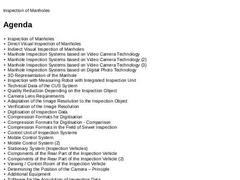
|
|
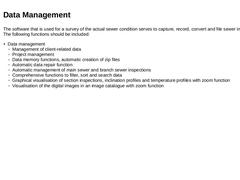
|
The software that is used for a survey of the actual sewer condition serves to capture, record, convert and file sewer inspection data. The following functions should be included: -
Data management
-
Management of client-related data
-
Project management
-
Data memory functions, automatic creation of zip files
-
Automatic data repair function
-
Automatic management of main sewer and branch sewer inspections
-
Comprehensive functions to filter, sort and search …
|
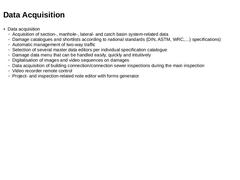
|
-
Data acquisition
-
Acquisition of section-, manhole-, lateral- and catch basin system-related data
-
Damage catalogues and shortlists according to national standards (DIN, ASTM, WRC,…) specifications)
-
Automatic management of two-way traffic
-
Selection of several master data editors per individual specification catalogue
-
Damage data menu that can be handled easily, quickly and intuitively
-
Digitalisation of images and video sequences on damages
-
…
|
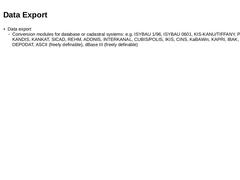
|
-
Data export
-
Conversion modules for database or cadastral systems: e.g. ISYBAU 1/96, ISYBAU 0601, KIS-KANU/TIFFANY, PROKIS, KANDIS, KANKAT, SICAD, REHM, ADONIS, INTERKANAL, CUBIS/POLIS, IKIS, CINS, KaBAWin, KAPRI, IBAK, PoyGIS, VSA, DEPODAT, ASCII (freely definable), dBase III (freely definable)
|
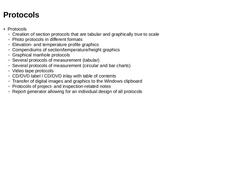
|
-
Protocols
-
Creation of section protocols that are tabular and graphically true to scale
-
Photo protocols in different formats
-
Elevation- and temperature profile graphics
-
Compendiums of section/temperature/height graphics
-
Graphical manhole protocols
-
Several protocols of measurement (tabular)
-
Several protocols of measurement (circular and bar charts)
-
Video tape protocols
-
CD/DVD label / CD/DVD inlay with table of contents
-
Transfer of digital …
|
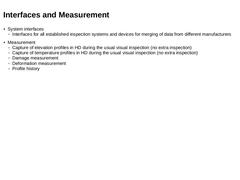
|
-
System interfaces
-
Interfaces for all established inspection systems and devices for merging of data from different manufacturers
-
Measurement
-
Capture of elevation profiles in HD during the usual visual inspection (no extra inspection)
-
Capture of temperature profiles in HD during the usual visual inspection (no extra inspection)
-
Damage measurement
-
Deformation measurement
-
Profile history
|
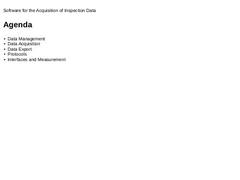
|
|
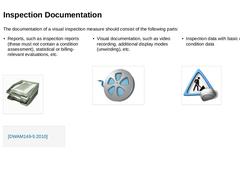
|
The documentation of a visual inspection measure should consist of the following parts: -
Reports, such as inspection reports (these must not contain a condition assessment), static calculation or billing-relevant evaluations, etc.
-
Visual documentation, such as video recording, additional display modes (unwinding), etc.
-
Inspection data with basic data and condition data
(Image: Picto Desk Storage Schreibtisch Ablage Archiv) (Image: Picto Video Film … |
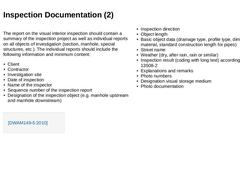
|
The report on the visual interior inspection should contain a summary of the inspection project as well as individual reports on all objects of investigation (section, manhole, special structures, etc.). The individual reports should include the following information and minimum content: -
Client
-
Contractor
-
Investigation site
-
Date of inspection
-
Name of the inspector
-
Sequence number of the inspection report
-
Designation of the inspection object (…
|
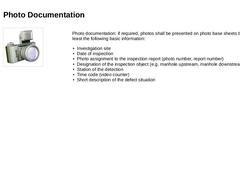
|
(Image: Picto Foto Images Fotoapparat) Photo documentation: if required, photos shall be presented on photo base sheets that include at least the following basic information: -
Investigation site
-
Date of inspection
-
Photo assignment to the inspection report (photo number, report number)
-
Designation of the inspection object (e.g. manhole upstream, manhole downstream)
-
Station of the detection
-
Time code (video counter)
-
Short description of the defect …
|